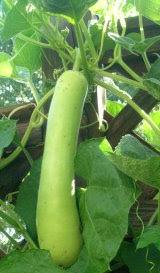Authors: Manjusha Verma, Lalit Arya
NBPGR, Pusa Campus, New Delhi -110012

Bottle gourd (Lagenaria siceraria) is a vegetable of Cucurbitaceae family that grows in the tropics and sub-tropics. It is harvested as a tender fruit for consumption as a vegetable. Its fruits are usually light green in colour, smooth skin with white flesh and seeds. It can be bottle- shaped or round like a calabash and can vary in size from very small to about a meter long. It is an important vegetable in the Asian and African cuisine.
It is also used for decorative purposes as a bottle, utensil or pipe when it matures. It probably originated in Africa, where it occurs in the wild as also in India. It is a widely cultivated crop in India, Sri Lanka, Malasia, Indonesia, China, Philippines, Africa and South America. In fact, it happens to be one of the first domesticated crops of humankind dating back to 10, 000 years, long before the other crops or livestock were cultivated. It was first used as a bottle, cup or container. Culturally, it has also been used as a lute (a musical instrument), sounding box of the Sitar and ektara by bauls in Bengal. The hard dry fruit has also been utilized for ornamental purposes. There is a renewed interest in this crop due to its rich nutritional profile and manifold medicinal prospects.
Bottle gourd is a rich source of fibre rendering it a superior worth for digestive ailments. Raw fruit contains 95.5% water and only 3.5%carbohydrates. It is very low in saturated fats, cholesterol and has good amounts of calcium, magnesium, manganese, potassium and zinc. It is a good inclusion as a food for obesity control as it has high fullness factor along with high nutrient levels. The table below presents the amounts of nutrients in a 100g portion of raw bottle gourd in relation to percentage daily values (%DV):
| Nutrient | Amount | %DV |
| Calories | 13.8 | 0.7 |
| Total fat | 0 | 0 |
| Protein | 0.69g | 1.7 |
| Vitamin C | 10.2mg | 17.2 |
| Niacin | 0.35mg | 1.8 |
| Folate | 6mcg | 1.7 |
| Pantothenic acid | 0.17mcg | 1.7 |
| Calcium | 26mg | 3.5 |
| Iron | 0.18mg | 1.6 |
| Magnesium | 11mg | 3.4 |
| Phosphorus | 12.9mg | 1.7 |
| Potassium | 150 | 3.5 |
| Zinc | 0.7mg | 5.3 |
The health benefits reported in bottle gourd include its anti-cancerous, cardioprotective, general tonic, antidote to certain poisons and scorpion stings, diuretic, aphrodisiac, purgative and cooling effects. It can also be used to cure ulcers, mitigate pain and fever and is used for pectoral cough, asthma and other bronchial disorders. Usual usage is as a cooked vegetable, in soups and can also be used as a juice from the tender fruits.
The cooked vegetable gives a feeling of relaxation and is is cooling, diuretic, sedative and antibilious . Owing to its high fiber content (0.6%) a diet rich in bottle gourd preparations is good for flatulence, constipation and other digestive disorders. Its juice is used for treating stomach ulcers, indigestion and acidity as well as for the treatment of epilepsy, insanity and other nervous disorders.
Owing to these numerous health benefits a lot of research into developing new varieties of bottle gourd and deciphering its genome is being embarked upon globally. At NBPGR the Indian germplasm is being conserved at the Genebank and its morphological and molecular characterization is being undertaken.
References:
1. Fard MH, Bodhankar SL, Dikshit M (2008) Cardioprotective activity of fruit of Lagenaria siceraria (Molina) Standley on Doxorubicin induced cardiotoxity in rats. International Journal of Pharmacology 6:466â€"471
2. www.nutritiondata.com
3. Badmanaban R, Patel CN (2010) Journal of Global Pharma Technology 4:66â€"70
4. Upaganlawar A, Balaraman R (2010) Protective effects of Lagenaria siceraria (Molina) fruit juice in isoproterenol induced myocardial infarction. International Journal of Pharmacology 5:645â€"651
About Author / Additional Info: